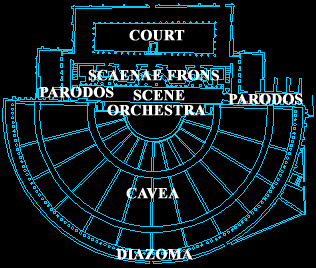|
History of Construction and
Use:
Archaeological evidence for the
Greek theater dates originally to the late fifth century B.C.,
at which time there existed an orchestra and a seating
area, or cavea, which was built into the side of a hill
(Figure 1). There also existed stone seats built into the cavea
and a wooden scene building to the north of the orchestra.
In the Hellenistic period, in the third century B.C., a new
orchestra was built and a new and expanded scene building was
constructed. In the Roman period, likely in the time of the
emperor Augustus, the cavea was extended in size to the north
on both the east and west sides. A new orchestra was constructed
as well as a new stage building.
Restoration work was done to the
theater at the end of the first century A.D. or at the beginning
of the second century. An elaborate three-story scaenae frons,
decorated with sculpture, was added in the second century A.D.
During the reign of the emperor
Caracalla (211-217 A.D.), the orchestra was converted
into an arena and the lowest 10 rows of seats, original to the
Roman cavea, were eliminated. A wall 3.50 m high was
constructed around the arena at the time of conversion. It is
possible that the cavea was rebuilt at the same time
to increase the slope of the spectator area.
Pictures from the Theater:






- Theater after excavation
- Dedication inscription of Erastus
- Foundation of monumental gateway
of Decumanus II and theater, looking southwest
- Scaenae frons
foundation and theater looking southwest
- Theater cavea and orchestra
looking south
- Theater looking southeast
Bibliography:
- Stillwell, R.L. Corinth,
II; The Theater. Princeton, 1965.
- Sturgeon, M. Corinth IX,
ii; Sculpture: The Reliefs from the Theater. Princeton,
1977.
- Williams, C.K. II, and Orestes
H. Zervos, "Corinth, 1988: East of the Theater," Hesperia
58 (1989) 1-50.
|

Figure
1: Restored plan of the theater in Corinth, A.D. 150
Click
on the figures to enlarge.

Figure
2: Actual state of the theater

Figure
3: Actual state, detail of the orchestra
|









